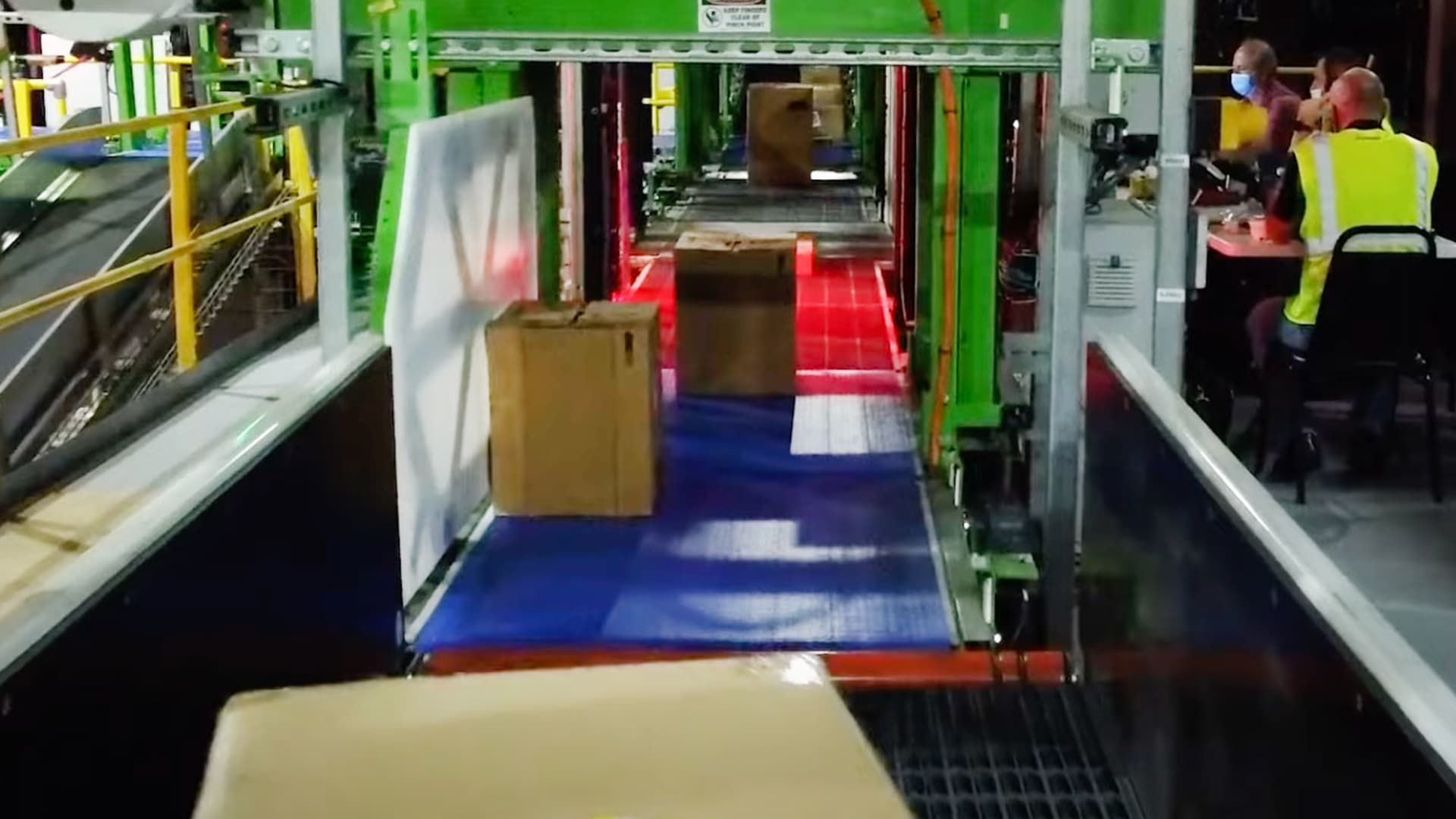BROOKSVILLE, Fla. — At first glance, this warehouse looks like many: Forklifts unload pallets from the back of dozens of tractor trailers. Canned soup, soda and cleaning supplies whiz by on conveyer belts. Store-bound merchandise gets sorted by department and store aisle before getting stacked high like an elaborate game of Tetris.
The difference? Tasks are powered by giant automated claws and rolling robots, instead of people. The driver’s seats on the forklifts are empty.
related investing news
Welcome to the future of Walmart.
The big-box retailer at an investor event last week previewed how it plans to use automation to more quickly and cost effectively manage inventory, stock shelves and keep up with online orders. The company took investors on a tour of an approximately 1.4 million-square-foot facility in Brooksville, Florida — the first automated distribution center for packaged foods and other shelf-stable household items.
Walmart plans to add that same automation from Symbotic — a warehouse technology company that Walmart took a majority stake in last year — to all of its 42 regional distribution centers, though it didn’t share a timetable for doing so. By the end of January, roughly a third of stores will get distribution from the automated facilities, the company said.
Walmart’s automation is a piece of a broader plan to drive profits higher. CEO Doug McMillon said in the coming years the retailer’s revenue will grow about 4% year over year — a slower growth rate than the approximately 8% it saw in the past three pandemic-fueled years, but still faster than growth of 3.1% and 3.6% the retailer posted in the three years prior to the pandemic.
McMillon added that he expects profits to grow at a quicker pace than sales over the next five years as Walmart adds automation and grows its higher-margin businesses like advertising, last-mile delivery and fulfillment services.
He said Walmart has given customers more ways to shop online and get those purchases faster. It offers more general merchandise, including exclusive brands in categories like apparel. And it has more sellers that have joined its third-party marketplace, too.
“We’re now in a phase that is less about scaling store pickup and delivery, e-commerce assortment, and e-commerce FC [fulfillment center] square footage and more about execution and operating margin improvement,” he said.
In three years, Walmart anticipates that about two-thirds of its stores will be serviced by some kind of automation, about 55% of fulfillment center volume will move through automated facilities and that unit cost averages could improve by about 20%.
Workforce shifts
For Walmart, the country’s largest employer, the automation push means rendering obsolete some of its 1.6 million roles.
At the Brooksville facility during the investor tour, few people appeared to be on the distribution center’s floor, though Walmart said its overall headcount at the facility hasn’t changed.
David Guggina, executive vice president of Walmart U.S.’s supply chain operations, said automation is about increasing capacity, not cutting jobs. He said retention has significantly improved, since work is not as physically demanding. He declined to share specific turnover numbers, but said the first year after the Brooksville facility became automated, no employees left the job.
In an interview with CNBC, McMillon said he anticipates the retailer’s workforce will stay about the same size. But he said its composition will change. For example, he said, Walmart may need fewer people to unload pallets at warehouses, but more people to deliver online orders to customers’ doors.
Walmart recently laid off hundreds of workers at e-commerce facilities across the country. McMillon said those layoffs came after a surge in online sales during the early years of the pandemic, as the company tried to understand what its sales trends would look like beyond the holidays.
Walmart has not shared how much it will spend on the automation projects. At last week’s investor event, Chief Financial Officer John David Rainey said the company expects its capital expenditures will be slightly higher than last year, at roughly 2.5% to 3% of sales.
He said about 90% of the company’s capex will be in “high-return areas” like e-commerce, supply chain and store investments.
As Walmart plans for the bigger rollout, some employees have already had a change in their routines. Jose Molina, who shared his experience as part of the organized tour, began working at the Brooksville distribution center in 1995. For years, he said, he kept track of inventory with a pen and paper. He grew tired from lifting heavy boxes with a pallet jack or operating a forklift.
With the automation, Molina watches the robots unload the truck and intervenes if they run into a problem, he said. Scanners keep count of each item, so he can skip the pen and paper or mental math. He leaves work without feeling exhausted and coaches high school soccer at the end of his day.
“I even kick the ball sometimes,” he said.
Bearing fruit
Brad Thomas, a retail analyst for KeyBanc Capital Markets, took a tour of the Tampa area facility during the investor event. He said he was sold on the investments after seeing real-world results in the back of a nearby store.
Thomas referred to two trailers, packed with pallets and ready to unload from the distribution center. One was packed manually by employees and included a bunch of items from numerous departments piled in a haphazard stack. A box of Pop-Tarts precariously propped up other items at the bottom of the towering pallet.
The other trailer was packed by a robot, organized with the help of automation for fast and easy unloading for workers. Like items together, heaviest at the bottom.
The contrast, Thomas said, helps highlight what he views as a significant transformation for Walmart — the company’s “most exciting setup that it’s had in the past 10 years.”
“Ten years ago, Walmart was still playing catch-up in areas like e-commerce, and I think that many of the investments they have made are bearing fruit,” he said. “We’re actually seeing areas like automation where arguably Walmart is more of a leader than a follower.”
Other retailers are pushing into automation, too. Grocery giant Kroger is opening huge, robot-powered sheds with U.K.-based Ocado to expand its online grocery business, including one that allowed it to break into the Florida market without building a single store.
Amazon has increasingly automated the picking and sorting of packages in its warehouses. Its $775 million acquisition of Kiva Systems in 2012 was a pivotal moment in that transition, giving Amazon access to robots that can carry shelves of goods from worker to worker, speeding up the fulfillment process.
Walmart is banking on automation to help get more online orders to customers next-day or with two-day shipping. The retailer currently picks, packs and ships orders at 31 fulfillment centers across the country, and it has plans to build four automated fulfillment centers, including one that’s already opened in Joliet, Illinois, 45 miles southeast of Chicago.
The retailer has an additional 46 distribution centers to support the fresh side of its grocery business and has an automated grocery distribution center in Shafter, California. It has plans to open another in Lancaster, Texas, later this year and one in Spartanburg, South Carolina, next year.
It’s also testing mini fulfillment centers in the back of stores where employees work side-by-side with automation to get online grocery orders ready.
— CNBC’s Annie Palmer contributed to this report.


